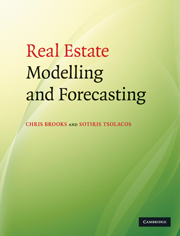Book contents
- Frontmatter
- Contents
- List of figures
- List of tables
- List of boxes
- Preface
- Acknowledgements
- 1 Introduction
- 2 Mathematical building blocks for real estate analysis
- 3 Statistical tools for real estate analysis
- 4 An overview of regression analysis
- 5 Further issues in regression analysis
- 6 Diagnostic testing
- 7 Applications of regression analysis
- 8 Time series models
- 9 Forecast evaluation
- 10 Multi-equation structural models
- 11 Vector autoregressive models
- 12 Cointegration in real estate markets
- 13 Real estate forecasting in practice
- 14 The way forward for real estate modelling and forecasting
- References
- Index
7 - Applications of regression analysis
Published online by Cambridge University Press: 05 June 2012
- Frontmatter
- Contents
- List of figures
- List of tables
- List of boxes
- Preface
- Acknowledgements
- 1 Introduction
- 2 Mathematical building blocks for real estate analysis
- 3 Statistical tools for real estate analysis
- 4 An overview of regression analysis
- 5 Further issues in regression analysis
- 6 Diagnostic testing
- 7 Applications of regression analysis
- 8 Time series models
- 9 Forecast evaluation
- 10 Multi-equation structural models
- 11 Vector autoregressive models
- 12 Cointegration in real estate markets
- 13 Real estate forecasting in practice
- 14 The way forward for real estate modelling and forecasting
- References
- Index
Summary
Learning outcomes
In this chapter, you will learn how to
undertake all the stages involved in designing, building and evaluating an empirical econometric model in real estate through two detailed examples.
The regression analysis topics of chapters 4 to 6 are fundamental to conducting empirical research in real estate. Given the importance of regression in real estate analysis, we devote this chapter to more examples of multiple regression. We give two detailed illustrations, with the aim of further familiarising the reader with key tasks in the empirical estimation of a multiple regression model and particularly in model construction and selection. In chapters 4 to 6, we examined regressions with time series data, the most common form of data in real estate modelling. This chapter also presents an example with cross-sectional data. The estimation principles are identical but the focus of the illustration is also on the interpretation and usage of cross-section analysis.
Frankfurt office rents: constructing a multiple regression model
We focus on modelling office rents using a multiple regression model and use data for the Frankfurt office market. Our specification is guided by theory, as any good empirical model of the real estate market should be. Hence the empirical model of Frankfurt office rents in this example is driven by the a priori treatment of office rent determination originating in theoretical frameworks of real estate market dynamics put forward in a number of studies (e.g. DiPasquale and Wheaton, 1992; Clapp, 1993; RICS [Royal Institution of Chartered Surveyors], 1994; Ball, Lizieri and MacGregor, 1998).
- Type
- Chapter
- Information
- Real Estate Modelling and Forecasting , pp. 194 - 224Publisher: Cambridge University PressPrint publication year: 2010



